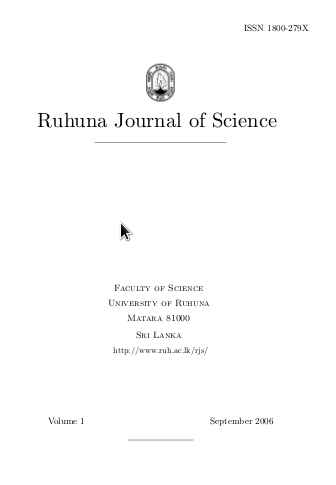Evaluation of antibacterial activity of different mangrove plant extracts
Abstract
Antibacterial activity of mature leaves, tender leaves and bark extracts of Avicennia marina, Avicennia officinalis and Bruguiera sexangula were evaluated using Soxhelt extraction method. Petroleum ether, chloroform, ethyl acetate and ethanol were used as solvents in order to get the plant extracts. The antibacterial activity was screened by using agar diffusion technique against pathogenic bacteria species of Staphylococcus sp. (from urine), Proteus sp. (from a wound), Escherichia coli (from infected blood), Shigella sp. (from a wound) and Pseudomonas sp. (from a wound). The length of inhibition zone was measured in millimeters from the edge of the well to the edge of the inhibition zone. Twelve different plant extracts in A. marina, A. officinalis and B. sexangula exhibited different degree of growth inhibition against tested bacterial strains. Mature leaf extracts of A. marina and tender leaf extracts of A. officinalis in ethyl acetate exhibited promising antibacterial activity than other plant extracts. All plant extracts in ethyl acetate showed strong inhibition compared to other extracts on all tested bacterial strains. Among all bacterial strains, Pseudomonas sp. and E. coli showed considerable growth inhibition against almost all plant extracts. Mature leaf extract of only A. marina was used for further investigations since a large amount of tender leaves of A. officinalis was not readily available. Charcoal treated mature leaf extracts of A. marina showed more inhibition for all tested bacterial strains than untreated plant extracts. Combinations of mature leaf extracts of A. marina in different solvents failed to exhibit synergistic activity against tested bacterial strains. Most combinations showed antagonistic effect against Proteus sp., E. coli and Shigella sp. Antibacterial activity of plant extracts of A. marina gradually declined during 4 months after extraction, for all tested bacterial strains. Components of mature leaf extracts of A. marina in chloroform, ethyl acetate and ethanol were separated by Analytical Thin Layer Chromatography (ATLC) when the eluents were hexane and diethyl ether. Isolated components in Preparative Thin Layer Chromatography (PTLC) exhibited moderate antibacterial activity against Pseudomonas sp., Shigella sp. and E. coli. Separated components did not show any antibacterial activity against Proteus sp. and Staphylococcus sp. Phytochemical screening revealed that mature leaf of A. marina contained alkaloids, steroids, triterpenoids and flavonoids.References
Abeysinghe PD,WithanawasamM, Pathirana RN, Abeysinghe S. 2002. Preliminary in vitro screening of antibacterial compounds of some mangrove plant extracts for clinical isolates from different sources. Proceeding of the First Science Symposium, University of Ruhuna, 22-25 pp.
Abeysinghe PD, Wijesekara D, Pathirana RN. 2003. Inhibition of growth of antibiotic resistant Staphylococcus sp. and Proteus sp. by mangrove plant extracts. Proceeding of the First Science Symposium, University of Ruhuna, 1-9 pp.
Bandaranayake WM. 1995. Survey of mangrove plants from Northern Australia for phytochemical constituents and uv-absorbing compounds. Current Topics in Phytochemistry (Life Science Advances) 14:69-78
BandaranayakeWM. 1998. Traditional and medicinal uses of mangroves. Mangroves and Salt Marshes. 2:133-148.
de Castillo MC, de Nader OM, de R. Holgado AP. 1998. In vitro comparison of disk diffusion and agar dilution antibiotic susceptibility test methods for Neisseria gonorrhoeae. 93(4):517.
Harbone JB. 1984. Phytochemical methods. 2nd edition. Chapman and Hall, London.
Schwarz S, Noble WC. 1999. Aspects of bacterial resistance to antimicrobials used in veterinary dermatological practice. 163-176 pp.
Withanawasam DM. 2002. Preliminary in vitro screening of antibacterial and anti-fungal compounds of mangrove plant extracts for pathogens from different sources.
Downloads
Published
Issue
Section
License
From Volume 7 (2016) onwards, all articles published in Ruhuna Journal of Science are Open Access articles published under the Creative Commons CC BY-NC 4.0 International License. This License permits use, distribution and reproduction in any medium, provided the original work is properly cited and is not used for commercial purposes.
Copyright on any research article published in RJS is retained by the respective author(s).
Authors who publish with this journal agree to the following terms:
a) Authors retain copyright and grant the journal right of first publication with the work simultaneously licensed under a Creative Commons Attribution License CC-BY-NC 4.0 International, that allows others to share the work with an acknowledgement of the work's authorship and initial publication in this journal.
b) Authors are able to enter into separate, additional contractual arrangements for the non-exclusive distribution of the journal's published version of the work (e.g., post it to an institutional repository or publish it in a book), with an acknowledgement of its initial publication in this journal.
c) Authors are permitted and encouraged to post their work online (e.g., in institutional repositories or on their website) prior to and during the submission process, as it can lead to productive exchanges, as well as earlier and greater citation of published work (See The Effect of Open Access).

